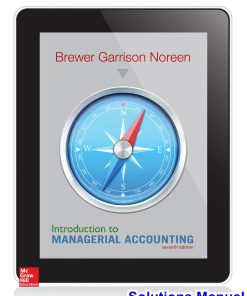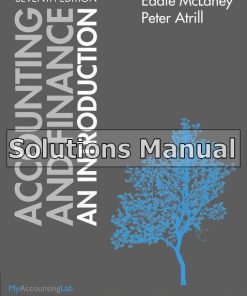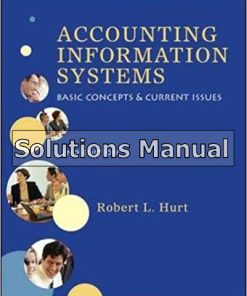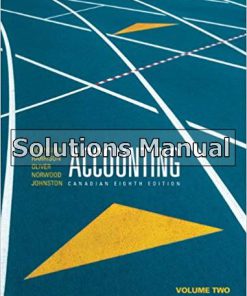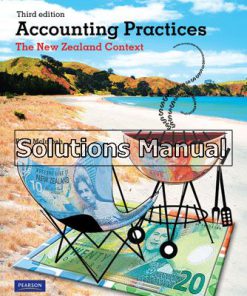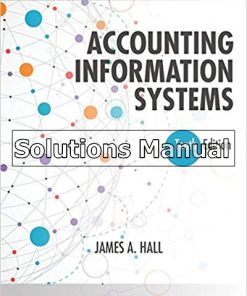Introduction to Managerial Accounting 6th Edition Brewer Solutions Manual
$26.50$50.00 (-47%)
Introduction to Managerial Accounting 6th Edition Brewer Solutions Manual.
You may also like
Introduction to Managerial Accounting 6th Edition Brewer Solutions Manual
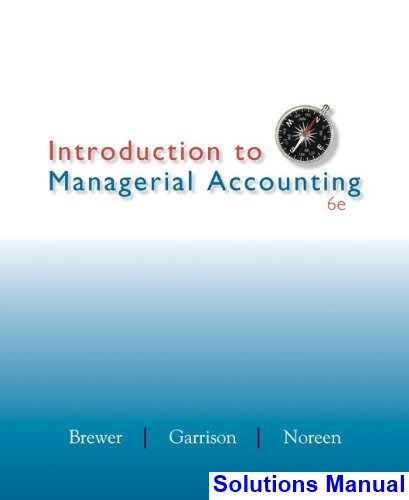
Product details:
- ISBN-10 : 0077630319
- ISBN-13 : 978-0077630317
- Author: Peter C. Brewer
Introduction to Managerial Accounting, 6/e by Brewer/Garrison/Noreen is based on the market-leading text, Managerial Accounting, by Garrison, Noreen and Brewer. Brewer 6e is a briefer, more accessible, and thoroughly student-friendly text that satisfies the basic needs of the managerial accounting student without unnecessary depth on advanced topics associated with the follow-up course cost accounting/cost management. Faculty and students alike will find this new edition has retained the hallmark features of the Garrison brand: author-written supplements, excellent readability, terrific examples, and balanced end-of-chapter material. In addition, Connect Accounting for Brewer/Garrison/Noreen has been expanded with new learning resources for your students.
Table contents:
- Chapter 1 An Introduction to Managerial Accounting
- The Management Cycle and the Need for Managerial Accounting Information
- Strategy
- Planning
- Implementation
- Control
- Financial and Managerial Accounting
- For the Managers
- Emphasis on the Future
- Relevance and Flexibility of Data
- Emphasis on Timeliness
- Focus on Segments of an Organization
- Regulation
- Managerial Accounting—Not Mandatory
- Are Financial and Managerial Accounting Independent?
- Increased Relevance of Managerial Accounting
- Globalization
- The Lean Business Model
- Just-in-Time
- The JIT Approach
- Zero Defects and JIT
- Total Quality Management
- The Plan–Do–Check–Act Cycle
- Process Reengineering
- The Theory of Constraints
- An Example of TOC
- TOC and Continuous Improvement
- Ethical Responsibility and Corporate Governance
- Professional Ethics
- Corporate Governance
- Implications of the Changing Business Environment on Managerial Accounting
- Organization of the Text
- Learning Objectives Summary
- Questions
- Exercises
- Problems
- Appendix 1A: Code of Ethics for Professional Accountants—International Federation of Accountants
- PART I: PRODUCT AND SERVICE COSTING
- Chapter 2 Cost Concepts
- Why Cost Classification Is Important to Managers
- Cost Classification by Behaviour
- Variable Cost
- Fixed Cost
- Cost Classification by Traceability
- Direct Cost
- Indirect Cost
- Cost Classification by Relevance
- Differential Cost and Revenue
- Opportunity Cost
- Sunk Cost
- Cost Classification by Function
- Manufacturing Costs
- Nonmanufacturing Costs
- Product Costs Versus Period Costs
- Product Costs
- Period Costs
- Cost Classifications on Financial Statements
- The Balance Sheet
- The Income Statement
- Schedule of Cost of Goods Manufactured
- Product Costs—A Closer Look
- An Example of Cost Flows
- Cost Classification Summary
- Learning Objectives Summary
- Application Competency Summary
- Review Problem 1: Cost Terms
- Review Problem 2: Schedule of Cost of Goods Manufactured and Income Statement
- Questions
- The Foundational 15
- Brief Exercises
- Exercises
- Problems
- Building Your Skills
- Chapter 3 Systems Design: Job-Order Costing
- The Purpose of Costing Systems
- Types of Costing Systems
- Job Shops and Job-Order Costing
- Flow Shops and Process Costing
- Approaches to Costing—Key Management Decisions
- Absorption Versus Variable Costing Approaches
- Normal Versus Actual Costing Approaches
- Overhead Cost Allocation Approaches
- An Overview of Job-Order Costing—Determining the Cost of a Specific Job
- Measuring Direct Materials Cost
- Job Cost Sheet
- Measuring Direct Labour Cost
- Application of Overhead
- Choice of an Allocation Base for Overhead Cost
- Computation of Job Costs
- Cost Flows in a Job-Order System
- The Purchase and Issue of Materials
- Labour Cost
- Manufacturing Overhead Costs
- Cost of Goods Manufactured
- Cost of Goods Sold
- Summary of Manufacturing Cost Flows
- Under- and Overapplied Overheads
- Causes of Under- and Overapplied Overheads
- Disposition of Under- or Overapplied Overhead Balances
- Multiple Predetermined Overhead Rates
- Nonmanufacturing Costs
- Learning Objectives Summary
- Application Competency Summary
- Review Problem: Job-Order Costing
- Questions
- The Foundational 15
- Brief Exercises
- Exercises
- Problems
- Building Your Skills
- Chapter 4 Process Costing
- Comparison of Job-Order and Process Costing
- Similarities Between Job-Order and Process Costing
- Differences Between Job-Order and Process Costing
- Process Cost Flows
- The Flow of Materials, Labour, and Overhead Costs
- Materials, Labour, and Overhead Cost Entries
- Product Cost Categories in a Process Costing System
- Measuring Production Volume in a Process Costing Environment: The Quantity Schedule
- The Flow of Physical Units
- Challenge of Measuring Production Activity: Whole Units Versus Partially Completed Units
- The Concept of Degree of Completion
- Equivalent Units of Production
- The Quantity Schedule
- Product Costing in a Process Costing Environment: The Weighted Average Cost Method
- Measuring Production Activity—WACM
- Cost per Equivalent Unit—WACM
- Cost Accounting—WACM Approach
- The Production Report: WACM
- Product Costing in a Process Costing Environment—FIFO Approach
- Costs to Allocate: FIFO
- Measuring the Volume of Production—FIFO
- Cost per Equivalent Unit: FIFO
- Cost Accounting—FIFO Approach
- Production Report—The FIFO Method
- A Comparison of Costing Methods
- The Logic of the WACM Calculation of Cost per EU
- WACM and FIFO Method: A Summary
- Learning Objectives Summary
- Application Competency Summary
- Review Problem: Process Cost Flows and Reports
- Questions
- The Foundational 15
- Brief Exercises
- Exercises
- Problems
- Building Your Skills
- Chapter 5 Activity-Based Costing
- Assigning Overhead Costs to Cost Objects
- Plantwide Overhead Rate
- Departmental Overhead Rate
- Activity-Based Costing
- Designing an Activity-Based Costing System
- Step 1: Identify Activities and Create an Activity Dictionary
- Step 2: Create Activity Cost Pools
- Step 3: Identify the Resources Consumed by Individual Activity Cost Pools
- Step 4: Identify the Activity Measure for Each Activity Cost Pool
- Step 5: Estimate the Total Activity Volume for Each Measure
- Step 6: Compute a Predetermined Activity Rate for Each Activity Cost Pool
- Step 7: Allocate Activity Costs to Desired Cost Objects
- Using Activity-Based Costing
- The Traditional Costing System
- The ABC System
- Computing Product Costs
- Comparison of the Two Approaches
- Activity-Based Costing in Nonmanufacturing Functions and Organizations
- Examples of Using Activity-Based Costing in Allocating Nonmanufacturing Costs
- Example of Using Activity-Based Costing in Service Companies
- Evaluating Activity-Based Costing
- Benefits of Activity-Based Costing
- Limitations of Activity-Based Costing
- Learning Objectives Summary
- Application Competency Summary
- Review Problem: Activity-Based Costing
- Questions
- The Foundational 15
- Brief Exercises
- Exercises
- Problems
- Building Your Skills
- PART II: PLANNING AND DECISION MAKING
- Chapter 6 Cost Behaviour: Analysis and Use
- Types of Cost Behaviour Patterns
- Variable Costs
- True Variable Versus Step-Variable Costs
- The Linearity Assumption and the Relevant Range
- Fixed Costs
- Types of Fixed Costs
- Fixed Costs and the Relevant Range
- Mixed Costs
- The Analysis of Mixed Costs
- Nonquantitative Approaches to Cost Analysis
- Quantitative Approaches to Cost Analysis
- The High–Low Method
- The Scattergraph Method
- The Least-Squares Regression Method
- Comparing the Three Methods
- Contribution Margin
- Learning Objectives Summary
- Application Competency Summary
- Review Problem 1: Cost Behaviour
- Review Problem 2: High–Low Method
- Questions
- The Foundational 15
- Brief Exercises
- Exercises
- Problems
- Building Your Skills
- Chapter 7 Budgeting
- Budgets
- Responsibility for Budgets
- Advantages of Budgeting
- An Overview of the Master Budget
- Choosing a Budget Period
- Zero-Based Budgeting
- Budgeting
- Preparing the Master Budget
- The Sales Budget
- The Production Budget
- Inventory Purchases—Merchandising Firm
- The Direct Materials Budget
- The Direct Labour Budget
- The Manufacturing Overhead Budget
- The Ending Finished Goods Inventory Budget
- The Selling and Administrative Expense Budget
- The Cash Budget
- The Budgeted Income Statement
- The Budgeted Balance Sheet
- Master Budget for a Merchandise Company
- Practical Issues in Budgeting
- Organizational and Financial Control Using Budgets
- Beyond Budgeting
- Learning Objectives Summary
- Application Competency Summary
- Review Problem 1: Budget Schedules
- Review Problem 2: Comprehensive Budget Preparation
- Review Problem 3: Interest Calculations in a Cash Budget
- Questions
- The Foundational 15
- Brief Exercises
- Exercises
- Problems
- Building Your Skills
- Chapter 8 Cost–Volume–Profit Relationships
- The Basics of CVP Analysis
- The Contribution Margin Income Statement
- Contribution Margin and CVP Analysis
- Contribution Margin Ratio and CVP Analysis
- CVP Relationships in Equation Form
- CVP Relationships in Graphical Form
- Assumptions of CVP Analysis
- Some Applications of CVP Concepts
- Example 1: Increase in Fixed Cost, Leading to an Increase in Sales Volume
- Example 2: Increase in Unit Variable Costs, Leading to an Increase in Sales Volume
- Example 3: Increase in Fixed Cost, Decrease in Selling Price, Leading to an Increase in Sales Volume
- Example 4: Increase in Variable Cost per Unit and Decrease in Fixed Cost, Leading to an Increase in
- Example 5: Calculation of Selling Price to Meet Profit Target
- Importance of the Contribution Margin
- Break-Even Analysis
- Break-Even Computations
- Target Profit Analysis
- The Effect of Income Tax
- The Margin of Safety
- CVP Considerations in Choosing a Cost Structure
- Cost Structure and Profit Stability
- Operating Leverage
- Learning Objectives Summary
- Application Competency Summary
- Review Problem 1: CVP Relationships
- Questions
- The Foundational 15
- Brief Exercises
- Exercises
- Problems
- Building Your Skills
- Chapter 9 Relevant Costs: The Key to Decision Making
- Cost Concepts for Decision Making
- Identifying Relevant Costs and Benefits
- Common Mistakes to Avoid in Relevant Cost Analysis
- Adding and Dropping Product Lines and Other Segments
- An Illustration of Cost Analysis
- Beware of Allocated Fixed Costs
- The Make-or-Buy Decision
- Opportunity Cost
- Special Orders
- Pricing New Products: Target Costing
- Utilization of a Constrained Resource
- Contribution in Relation to a Constrained Resource
- Managing Constraints
- Joint Product Costs and the Contribution Approach
- Sell-or-Process-Further Decisions
- Learning Objectives Summary
- Application Competency Summary
- Review Problem 1: Relevant Costs
- Review Problem 2: Adding a Product Line
- Questions
- The Foundational 15
- Brief Exercises
- Exercises
- Problems
- Building Your Skills
- Chapter 10 Capital Budgeting Decisions
- Capital Budgeting—Planning Investments
- Typical Capital Budgeting Decisions
- The Time Value of Money
- The Net Present Value Method
- Emphasis on Cash Flows
- Simplifying Assumptions
- Choosing a Discount Rate
- Financing-Related Cash Flows
- An Extended Example of the Net Present Value Method
- Expanding the Net Present Value Method
- The Total Cost Approach
- The Incremental Cost Approach
- Least-Cost Decisions
- Preference Decisions—The Ranking of Investment Projects
- The Internal Rate of Return Method
- Calculating the Internal Rate of Return of a Project
- Interpretation and Use of the IRR
- Comparison of the IRR and NPV Methods
- Other Approaches to Capital Budgeting Decisions
- The Payback Method
- Payback and Uneven Cash Flows
- An Extended Example of Payback
- Evaluation of the Payback Method
- The Simple Rate of Return Method
- Criticisms of the SRR Method
- Postaudit of Investment Projects
- Learning Objectives Summary
- Application Competency Summary
- Review Problem: Comparison of Capital Budgeting Methods
- Questions
- The Foundational 15
- Brief Exercises
- Exercises
- Problems
- Building Your Skills
- PART III: PERFORMANCE MANAGEMENT
- Chapter 11 Standard Costs and Variance Analysis
- Standard Costs
- The Standard Cost Card
- Ideal Versus Practical Standards
- Setting Direct Materials Standards
- Setting Direct Labour Standards
- Setting Variable Manufacturing Overhead Standards
- Preparing the Standard Cost Card
- The Static Budget
- Preparing the Static Budget
- Calculating the Budgeted Variable Manufacturing Costs: Two Alternative Cost Formulas
- Static Budget Performance Report
- The Flexible Budget
- Preparing the Flexible Budget for Evaluating Actual Performance
- Comparing the Flexible Budget and the Static Budget: Sales Volume Variances
- The Flexible Budget Performance Report: Flexible Budget Variances
- Flexible Budget Variance Analysis: Price and Quantity Variances
- A General Model for Standard Cost Flexible Budget Variance Analysis
- Variance Analysis: Direct Materials Variances
- Direct Materials Price Variance When the Quantity Purchased Does Not Equal the Quantity Used
- Management Control Using Direct Materials Variances
- Variance Analysis—Direct Labour Variances
- Direct Labour Rate Variance
- Labour Efficiency Variance
- Variance Analysis—Variable Overhead Variances
- Variable Overhead Spending (Rate) Variance
- Variable Overhead Efficiency Variance
- Summary of Variable Cost Variances
- Fixed Overhead Cost Variances
- The Nature of Fixed Costs of Manufacturing
- Control of Fixed Overhead Costs
- Fixed Overhead Budget Variance
- Overhead Application in a Standard Costing System and the Volume Variance
- Volume Variance for Colonial Pewter
- Interpretation of the Volume Variance
- A Note on the Denominator Activity Level
- Overhead Variances and Under- or Overapplied Overhead Cost
- The Flexible Budget Cost Variance Analysis Report
- Standard Costing and Variance Analysis in an Activity-Based Costing Environment
- Variance Analysis and Management by Exception
- Evaluation of Controls Based on Standard Costs
- Advantages of Standard Costs
- Potential Problems With Standard Costs
- Learning Objectives Summary
- Application Competency Summary
- Review Problem 1: Standard Costs and Variance Analysis
- Review Problem 2: Overhead Cost Variances
- Questions
- The Foundational 15
- Brief Exercises
- Exercises
- Problems
- Building Your Skills
- Chapter 12 Organizational Structure and Performance Measurement
- Decentralization in Organizations
- Advantages and Disadvantages of Decentralization
- Responsibility Centres
- An Example of Responsibility Centres
- Segmented Reporting
- Measuring and Controlling Investment Centre Performance
- Measuring Performance: The Return on Investment Formula
- Controlling the Rate of Return
- The ROI Levers for Controlling Performance: The DuPont Approach
- Increase Sales to Improve ROI
- Reduce Expenses to Improve ROI
- Reduce Assets to Improve ROI
- Criticisms of ROI
- Residual Income—Another Measure of Investment Centre Performance
- Motivation and Residual Income
- Divisional Comparison and Residual Income
- Computing Profitability of Non-Revenue-Generating Segments
- Multi-Dimensional Performance Measurement: The Balanced Scorecard
- Learning Objectives Summary
- Application Competency Summary
- Review Problem: Return on Investment and Residual Income
- Questions
- The Foundational 15
- Brief Exercises
- Exercises
- Problems
- Building Your Skills
- Chapter Sources
- Index
People also search:
introduction to managerial accounting 6th edition pdf
introduction to managerial accounting 6th canadian edition
introduction to managerial accounting 6th edition
introduction to managerial accounting 6th edition pdf free
introduction to managerial accounting 6th canadian edition pdf


